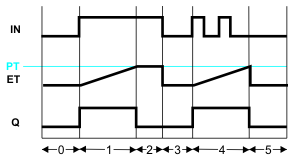|
Type
| Function blockTP is available as standard (non-safety-related) and safety-related type (TP_S). For the safety-related type, the safety-related data types (SAFE*) are expected at the formal parameters. There is no safety-related type for LTIME. |
|
Description
| Generates a pulse with a configurable pulse duration.
- When the IN input switches from FALSE to TRUE, the Q output is set to TRUE and remains set until the delay time specified at the PT input has elapsed.
- The Q output remains unchanged, if the IN input switches from TRUE to FALSE before the specified delay time has elapsed or if the input becomes TRUE for a second time before the delay time has elapsed.
- The PT input specifies the time after which Q is switched from TRUE to FALSE.
- The ET output indicates the already expired time.
|
|
Notes
|
- The input IN and the output Q can be negated.Note: The negation of formal parameters is not supported in safety-related code (SNOLD).
- Function blocks have to be instantiated. The instance name of the function block has to be declared in the 'Variables' table of the POU where the FB is going to be used. The instance name must be unique within the POU.
|
|
Parameters
| Inputs
 IN IN
| Data type: | (SAFE)BOOL |
| Description: | If a rising edge is detected, a pulse is generated. |
 PT PT
| Data type: | TP / TP_S: (SAFE)TIMETP_LTIME: LTIME |
| Description: | Preset time interval for the pulse. The time value must be positive. |
Outputs
 Q Q
| Data type: | (SAFE)BOOL |
| Description: | TRUE if IN = TRUE and ET < PT.
FALSE if IN = FALSE and ET >= PT. |
 ET ET
| Data type: | TP / TP_S: (SAFE)TIMETP_LTIME: LTIME |
| Description: | Elapsed time interval. |
|
|
Timing Diagram
|  Timing diagram Timing diagram

| 0 | The IN input is FALSE. As a result, also Q is set to FALSE. |
| 1 | IN switches from FALSE to TRUE. Q is set to TRUE immediately and the measurement of the elapsed time is started. |
| 2 | The delay time PT has elapsed (ET = PT), Q is set to FALSE immediately independent of the IN input signal, which still remains TRUE in our example. |
| 3 | IN switches from TRUE to FALSE. Q output remains FALSE. |
| 4 | IN switches from FALSE to TRUE. Q is set to TRUE immediately and the measurement of the elapsed time is started.Before the delay time PT has elapsed, IN switches repeatedly from TRUE to FALSE and vice versa. Q remains TRUE as the PT has not expired yet. |
| 5 | The PT has elapsed (ET = PT), Q is set to FALSE immediately. |
|
 IN
IN
 PT
Outputs
PT
Outputs
 Q
Q
 ET
ET
 Timing diagram
Timing diagram
